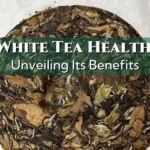White tea, a delicate and minimally processed tea variety, has been gaining popularity among tea enthusiasts worldwide. Known for its subtle flavors and potential health benefits, white tea has become a sought-after beverage for those looking to explore beyond traditional green and black teas. If you’re wondering where to find high-quality white tea, including popular varieties like White Peony and Shou Mei, you’ve come to the right place. This comprehensive guide will explore the best sources for purchasing white tea and provide insights into what makes this tea so unique.
Comprehending White Tea: From Buds to Brew

Before diving into where to buy white tea, it’s essential to understand what makes this tea unique. White tea is renowned for its gentle processing methods, which involve minimal oxidation and handling of the tea leaves. Typically harvested in early spring, white tea is made from the youngest buds and leaves of the Camellia sinensis plant, the same plant used for all true teas.
The name “white tea” comes from the silvery-white hairs that cover the buds, giving the tea a distinctive appearance. This minimal processing allows white tea to retain many of its natural compounds, resulting in a beverage that’s both flavorful and potentially beneficial for health.
Two popular varieties of white tea are White Peony (Bai Mu Dan) and Shou Mei. White Peony is made from one bud and two leaves, offering a slightly fuller flavor than other white teas. On the other hand, Shou Mei is made from more mature leaves and has a stronger taste profile. Both varieties showcase the unique characteristics that make white tea a prized beverage among connoisseurs.
Sourcing High-Quality White Tea: From Local Shops to Online Marketplaces
When it comes to purchasing white tea, you have several options available. Each source has advantages, and the best choice for you will depend on factors such as convenience, selection, and desire for a personalized shopping experience.
| Source | Advantages |
|---|---|
| Specialty Tea Shops | Knowledgeable staff, opportunity to smell/sample teas, personalized experience. |
| Online Tea Retailers | Wide selection, rare varieties, detailed information, sample sizes available. |
| Direct from Tea Producers | Freshest tea, supports farmers, immersive experience through tours/tastings. |
| Gourmet Food Stores | Convenient, accessible selection of quality teas. |
| Tea Subscription Services | Curated selections, regular delivery, exploration of different varieties. |
- Specialty Tea Shops: Local tea shops specializing in high-quality teas are excellent places to start your white tea journey. These establishments often have knowledgeable staff who can guide you through the different varieties of white tea, including White Peony and Shou Mei. Many specialty shops offer the opportunity to smell and sometimes even sample teas before purchasing, allowing you to find a white tea that suits your palate.
- Online Tea Retailers: The internet has made accessing a wide variety of white teas worldwide easier than ever. Reputable online tea retailers often have extensive selections of white teas, including rare and limited-edition varieties. When shopping online, look for retailers that provide detailed information about their teas, including origin, harvest date, and tasting notes. Some online shops also offer sample sizes, allowing you to try different white teas without committing to a large quantity.
- Direct from Tea Producers: For the most authentic experience, consider purchasing white tea directly from producers or through platforms that connect consumers with tea farms. This approach ensures the freshest tea possible and supports small-scale tea farmers. Some tea producers offer tours and tastings, providing an immersive experience for tea enthusiasts.
- Gourmet Food Stores: High-end grocery stores and gourmet food shops often carry a selection of quality teas, including white tea varieties. While the selection may not be as extensive as specialty tea shops, these stores can be convenient options for purchasing white tea, especially if you want to try a new brand or variety.
- Tea Subscription Services: For those who enjoy regularly exploring new teas, subscription services can be an exciting way to discover different white tea varieties. These services often curate selections of high-quality teas, including white teas, and deliver them to your doorstep regularly.
Choosing the Right White Tea: Tips for Discerning Buyers
When purchasing white tea, whether it’s White Peony, Shou Mei, or another variety, there are several factors to consider to ensure you’re getting a high-quality product:
| Factor | Tips |
|---|---|
| Appearance | Look for whole, intact leaves and buds with silvery-green color and downy hairs. |
| Aroma | Fresh white tea should have a delicate, sweet smell. |
| Origin | Tea from renowned regions like Fujian province is often of higher quality. |
| Harvest Date | Choose tea harvested within the last year for optimal freshness. |
| Processing Method | Authentic white tea is minimally processed; avoid flavored varieties. |
| Packaging | Airtight containers protect tea from light, moisture, and air. |
| Certifications | Optional organic or fair trade certifications ensure ethical production. |
- Appearance: High-quality white tea should consistently appear with whole, intact leaves and buds. Look for teas with a silvery-green color and visible downy hairs on the buds.
- Aroma: Fresh white tea should have a delicate, sweet smell. When you open the package, you should be greeted with a subtle, inviting scent that hints at the tea’s flavor profile.
- Origin: The origin of the tea can significantly impact its flavor and quality. White teas from renowned regions like Fujian province in China are often considered among the best.
- Harvest Date: Freshness is crucial for white tea. Look for teas with a recent harvest date, ideally within the last year.
- Processing Method: Authentic white tea should be minimally processed. Be wary of white teas that claim to be flavored or scented, as these additions can mask the tea’s natural qualities.
- Packaging: Proper packaging is essential for preserving the delicate flavors of white tea. Look for teas packaged in airtight containers that protect the leaves from light, moisture, and air.
- Certifications: Some white teas may carry organic or fair trade certifications. While not necessary for quality, these certifications can provide assurance about the tea’s production methods and ethical standards.
When exploring white teas, don’t hesitate to ask questions about the tea’s origin, processing, and recommended brewing methods. Reputable sellers should be able to provide detailed information about their products and may even offer brewing tips to help you get the most out of your white tea experience.
Conclusion
In conclusion, finding high-quality white tea, including varieties like White Peony and Shou Mei, is an adventure that can lead you to discover new flavors and experiences. Whether you explore local tea shops, online retailers, or direct-from-producer options, the world of white tea offers a wealth of choices for every palate. By understanding what to look for and where to find it, you can journey to discover the perfect white tea for your taste preferences.
Remember, the best white tea is about where you buy it and how you prepare and enjoy it. Take the time to brew your white tea carefully, using the appropriate water temperature and steeping time to unlock its full potential. With its delicate flavors and numerous potential health benefits, white tea is a beverage that rewards patience and appreciation.
We serve thousands of satisfied tea enthusiasts in our tea house each year, and we’re excited to share these exceptional teas with tea lovers worldwide at Orientaleaf.com.

References
- Heiss, M. L., & Heiss, R. J. (2007). The Story of Tea: A Cultural History and Drinking Guide. Ten Speed Press.
- Harbowy, M. E., & Balentine, D. A. (1997). Tea Chemistry. Critical Reviews in Plant Sciences, 16(5), 415-480.
- Willson, K. C., & Clifford, M. N. (Eds.). (1992). Tea: Cultivation to Consumption. Springer Science & Business Media.
- Pettigrew, J., & Richardson, B. (2008). The New Tea Companion: A Guide to Teas Throughout the World. Benjamin Press.
- Ukers, W. H. (1935). All About Tea. The Tea and Coffee Trade Journal Company.

